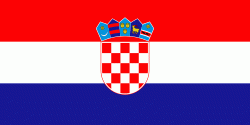Pag (Pag)
 |
Medieval Pag emerged near the salterns where the abandoned Old Town used to be, 3 km south of the present location. According to historical documents, the name Pag was mentioned for the first time in the 10th century. In 976, the Croatian king Stjepan Držislav took Pag from the Byzantine authority and appointed a Croatian district Prefect as the administrator of the town. In 1102, the Croatians voluntary formed a union with Hungary under King Coloman, as they had a succession crisis after the death of Demetrius Zvonimir. Hungary did agree to maintain the Croatian nobility, with the Sabor (Council of Croatian nobles) and a ban (Croat viceroy).
In 1244 Hungarian king Béla IV granted Pag the status of a free royal town. After the rebellion against Zadar, Pag obtained partial autonomy, and Ludovic I acknowledged its full autonomy in 1376 as to all other Dalmatian towns. In the battles against Zadar which took place in 1394, Pag suffered a heavy defeat and devastation, and the inhabitants moved to a new location, where the present Pag was founded.
In 1403, King Louis the Great, the King of Hungary and also of Croatia and Poland, sold his share of Dalmatia, Pag included, to Venice and thus sentenced Pag to a centuries-long life under Venetian rule. In 1433 Pag received the Town Statute, one of the first documents of that sort in Croatia.
In the middle of the 15th century, the Ottoman threat kept rising and therefore the inhabitants of Pag decided to build a new town. The construction works began on today's location of the town, on 18 May 1443. The urban plans of the new town were developed in Venice respecting the principles of architecture and urbanism of that time. Giorgio da Sebenico (= Juraj Dalmatinac), a great constructor and sculptor participated in the development of the urban plan.
In the 19th century, the town was ruled by the Austrian monarchy, Dalmatia Province, until the creation of the Kingdom of Serbs, Croats and Slovenes in 1918, under the bilingual name Pag-Pago.
In the late 19th century and the early 20th century, the town of Pag had 4700 inhabitants. In later years, and especially in 1905, following the emergence of a blight, which had destroyed the vineyards, the population started declining. Many inhabitants emigrated, mostly to the United States, Canada and Australia.
Another wave of depopulation of Pag town and island took place at the end of the Second World War. In this period, the nobility completely ceased to exist.
During the Croatian War of Independence in 1991, the only link between southern and northern Croatia was the island Pag, thanks to the bridge that connects it to the mainland on the south and a ferry line on the north of Pag.
Map - Pag (Pag)
Map
Country - Croatia
Currency / Language
| ISO | Currency | Symbol | Significant figures |
|---|---|---|---|
| HRK | Croatian kuna | kn | 2 |
| ISO | Language |
|---|---|
| HR | Croatian language |
| SR | Serbian language |

















